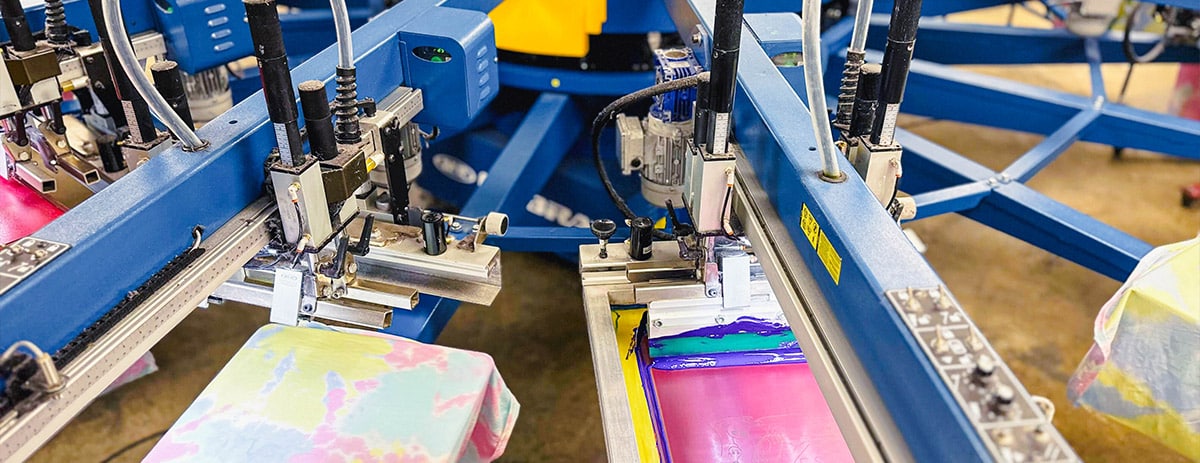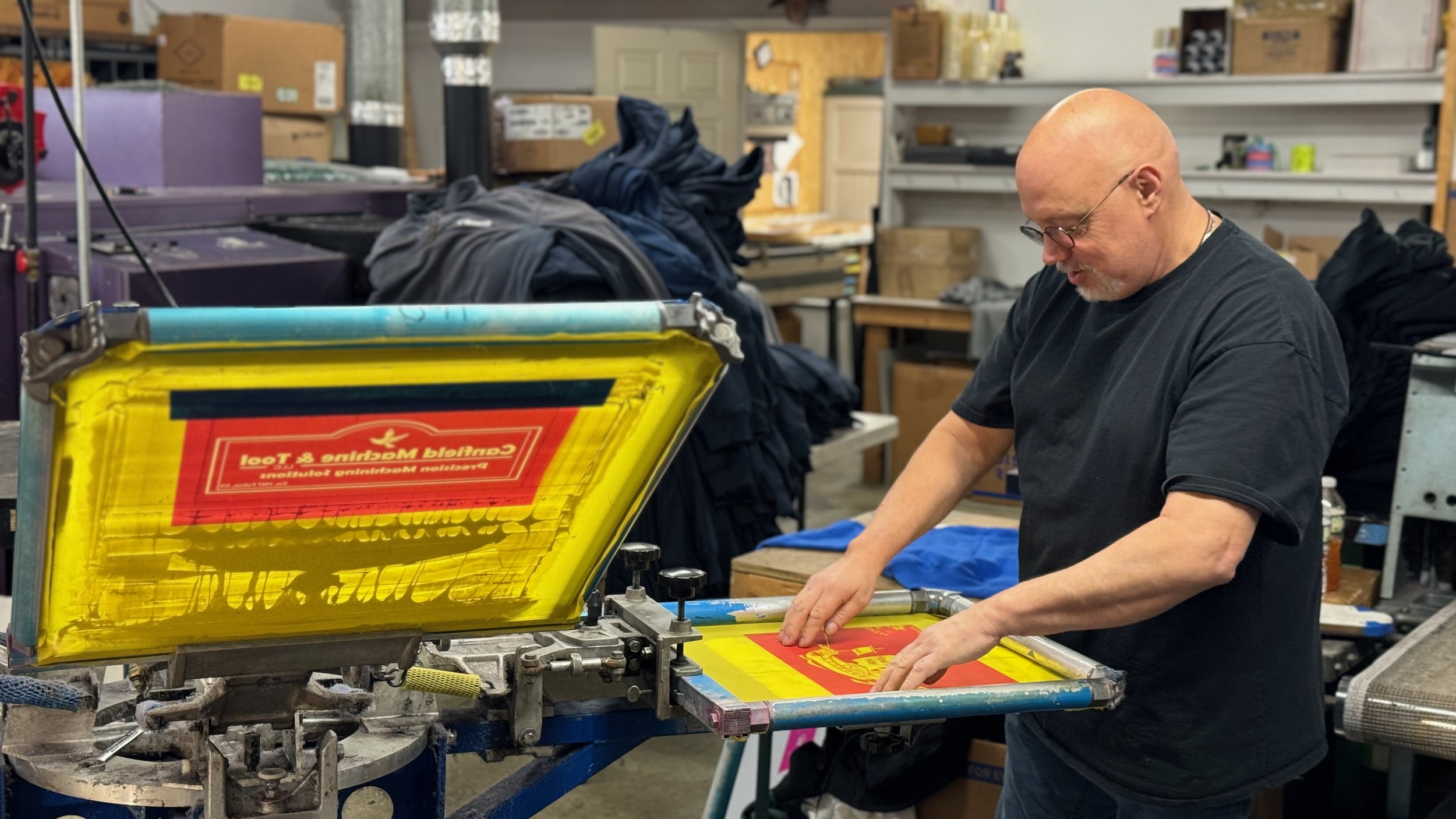Professional Screen Printing Kit for Custom Apparel
Professional Screen Printing Kit for Custom Apparel
Blog Article
Display Printing Uncovered: Whatever You Required to Understand About Tee and Garment Printing Techniques
Display printing is an interesting technique that integrates art with method, using unlimited possibilities for imagination. Ready to discover the crucial elements that make display publishing an art type?
The Fundamentals of Display Printing: Just How It Functions
When you plunge into display printing, you'll discover it's both an art and a science. At its core, display printing involves creating a stencil, or display, that enables ink to pass with just in certain areas.
Setting the display over the material, after that use a squeegee to press ink via the screen onto the garment. Each action is important, and understanding them will raise your display printing abilities, changing simple garments right into unique, meaningful items.
Types of Screen Printing Methods
As soon as you grasp the fundamentals of display printing, it's time to explore the different strategies that can elevate your styles. One prominent approach is conventional display printing, where ink is pressed through a stenciled screen. This method is fantastic for strong, vibrant colors. Then there's water-based ink printing, which uses a softer feeling and is environmentally friendly, yet it requires a different technique to curing.
If you're intending for great information, consider discharge printing. This technique eliminates color from the textile, leaving a soft, vintage look. One more alternative is plastisol printing, known for its resilience and brilliant shades, making it a preferred for lots of brands. Experiment with halftone printing to develop gradient results and complex designs. Each technique has its unique beauty, so don't hesitate to try them bent on discover what fits your design best!
Crucial Tools for Display Printing
To attain spectacular outcomes in screen printing, having the ideal devices is basic. You'll require a strong screen printing frame, which holds the mesh that moves your design onto the garment. Next, invest in top notch mops; these are vital for using ink evenly across the screen.
Picking the Right Inks and Materials
When picking inks and products for display printing, you require to think about the kind of ink that works finest for your job. Believe about material compatibility to ensure your styles look last and great lengthy. Check out environment-friendly ink alternatives to make your printing procedure more sustainable.
Sorts Of Screen Inks
Choosing the appropriate display ink is important for accomplishing vivid, durable prints that meet your job's requirements. There are a number of types of screen inks to check out. Specialized inks, such as glow-in-the-dark or metal, can add special results to your designs.

Textile Compatibility Factors To Consider
Comprehending material compatibility is crucial for attaining high-grade screen prints, particularly given that various products react distinctly to various inks. Constantly examine your inks on sample material to assure they adhere effectively and preserve color honesty. In addition, keep in mind that material weight and structure can affect the last end result, so picking the appropriate ink and material combination is important for your task's success.
Eco-Friendly Ink Options
Environmentally friendly inks are coming to be a preferred choice for screen printers who intend to lessen their environmental impact while preserving top quality. When selecting inks, think about water-based inks, which are much less dangerous and easier to clean up contrasted to standard solvents. These inks bond well with fabrics, providing vibrant results without hazardous chemicals. You may likewise explore eco-solvent inks that utilize less volatile natural compounds (VOCs), making them a much safer choice for both your health and wellness and the world.
Additionally, search for inks made from renewable energies, such as soy or vegetable-based options. By selecting the best inks and products, you'll not only develop magnificent styles however additionally add to a more lasting printing procedure. Make the button, and your prints will reflect your dedication to the atmosphere!
Preparing Your Layout for Display Printing

Submit Layout Demands
To assure your style looks sharp and dynamic on material, you'll need to pay very close attention to file style needs for display printing. Begin with vector files like AI or EPS, as they can be scaled without losing quality. If you use raster photos, decide for high-resolution data, such as TIFF or PNG, preferably at 300 DPI. Stay clear of utilizing JPEGs, as they can shed clarity when resized. Make sure your design has a clear background to prevent unwanted white sides on your prints. Maintain color settings in mind; CMYK is conventional for screen printing, so convert your RGB makes accordingly - screen printing kit. By adhering to he said these guidelines, you'll set your artwork up for an effective print.
Color Splitting Up Methods
Shade splitting up is an important action in preparing your layout for screen printing, and grasping it can considerably enhance your print high quality. You'll need to break your layout right into private colors, as each shade needs a separate display throughout printing. Start by identifying all the shades in your style and develop layers for each one. You can use software like Adobe Photoshop or Illustrator to separate and separate colors efficiently. Be particular to conserve each layer as a separate data, usually in a style like TIFF or PSD. This accuracy not just assures precise color representation yet likewise simplifies the printing process. By focusing on color separation, you'll attain lively and professional outcomes in your screen-printed garments.
Resolution and Dimension
Accomplishing the very best lead to display printing starts with ensuring your style has the right resolution and dimension. Preferably, your artwork ought to be at the very least 300 DPI (dots per inch) for sharp, clear prints. If you use lower resolution, your end product may look unprofessional and pixelated.
When it comes to size, think about the dimensions of your print area. Style your art work to match the last print size, preferably creating it in the real measurements you'll be publishing. In this manner, you'll avoid any kind of unexpected scaling issues.
Always inspect your layout in both vector and raster layouts. Vector graphics can be scaled without shedding top quality, making them suitable for display printing. Preparing properly will ensure your style looks incredible on every garment!
Step-by-Step Screen Printing Refine
Display printing is a dynamic process that enables you to produce dynamic layouts on numerous surfaces. To get begun, you'll require a display, solution, and your selected ink.
Put ink onto the display and use a squeegee to push the ink via the pattern onto the material. Lift the screen thoroughly and let the print dry. You've efficiently display printed your design.
Tips for Successful Display Printing Projects
While you're diving into your screen printing projects, keep in mind that prep work is essential to success. Start by collecting all your products-- inks, mops, garments, and displays. A tidy office aids prevent unwanted mistakes, so clean prior to you start.
Following, validate your art work is high-resolution and effectively sized for your garment. Check your display for proper direct exposure and clean it completely to stay clear of smudges. When mixing your inks, comply with the manufacturer's guidelines to accomplish the appropriate uniformity.
During printing, apply also pressure with your squeegee for constant outcomes. Do not rush; take your time to validate each print satisfies your criteria. After printing, let your garments dry totally prior to dealing with or packaging them.
Finally, constantly keep a sample of your benefit future referral. In this manner, you can examine your progression and improve your methods over time. Pleased printing!

Regularly Asked Questions
How much time Does It Take to Establish a Screen Printing Job?
Establishing a screen printing task commonly takes around thirty minutes to an hour. You'll prepare the screens, mix inks, and adjust the press. The moment differs based on complexity and experience, so remain arranged!
Can I Print on Various Textile Enters Utilizing the Same Technique?
Yes, you can publish on different fabric kinds making use of the exact same technique, but you'll require to change your inks and settings. Some materials absorb ink in a different way, so exploring assurances the very best outcomes for each and every product.
What Are Typical Errors to Avoid in Screen Printing?
When screen printing, stay clear of typical mistakes like utilizing the incorrect ink, ignoring correct exposure times, or missing pre-press checks. Constantly evaluate your setup and keep clean displays to guarantee top quality results each time.
Just How Can I Correctly Tidy and Maintain My Display Printing Equipment?
To appropriately clean and keep your screen site printing devices, you should frequently wash screens with appropriate solvents, examine squeegees for wear, and assure all devices are stored completely dry and dust-free. Uniformity protects against expensive repair services and enhances efficiency.
Is Screen Printing Eco-friendly Contrasted to Other Approaches?
Screen printing can be a lot more eco-friendly than various other methods, specifically if you use eco-conscious materials and water-based inks. By picking sustainable products and methods, you lower waste and lessen your influence on the world.
Screen Printing Uncovered: Every Little Thing You Need to Know Regarding T-Shirt and Garment Printing Methods
At its core, screen printing entails creating a pattern, or display, that allows ink to pass with just in specific Visit Website areas. Placement the display over the material, then use a squeegee to press ink via the screen onto the garment. One preferred technique is typical display printing, where ink is pressed with a stenciled screen.When picking inks and products for screen printing, you require to take into account the type of ink that works finest for your job.
Report this page